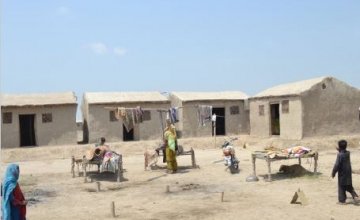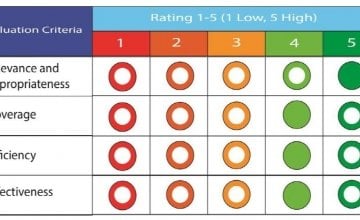
Read our 2024 annual report

Knowledge Hub
Responding to Pakistan's Internally Displaced (RAPID) Fund (RAPID Fund-II) Final Evaluation
“Responding to Pakistan’s Internally Displaced Population” (RAPID) Fund (RF) is an United States Agency for International Development’s Office of Foreign Disaster Assistance (USAID-OFDA) supported program in Pakistan implemented by Concern Worldwide. RAPID aims to assist the millions of people, including women and children in Pakistan, who are vulnerable as a result of large-scale man-made and natural disasters. These include displacement and return of millions of people from conflict-affected Federally Administered Tribal Areas (FATA) and Khyber Paktunkhwa (KP), large-scale floods, prolonged drought situations and three major earthquakes.

The first phase of RF was completed in 2013. The second phase of RF (RF-II) was launched in 2013 and completed in March 2019. A third phase of RF was approved and has commenced.
RF-II responded to four types of emergencies: complex, floods, earthquakes and drought emergencies. This report was commissioned by Concern Worldwide to evaluate RF-II program with a particular emphasis on the program relevance and appropriateness, coverage, coordination, efficiency, effectiveness and capacity building. A mixed method evaluation framework was adopted including both qualitative and quantitative methods. The qualitative methods included 58 Focus Group Discussions (attended by 539 participants including 235 women), 104 Key Informant Interviews (54 government officials), 37 Transect Walks and 651 household survey respondents (including 295 women). Quantitative data was collected from 10 districts covering over one-third of all RF-II program districts and 24 partners.

Key findings:
Relevance and Appropriateness: RF-II was highly relevant and appropriate to the needs of Pakistan, which is a country prone to natural disasters including floods, earthquakes, droughts and man-made disasters. The country is amongst the top-ten countries most affected from the climate change. INFORM, which is a collaboration of the Inter-Agency Standing Committee Task Team for Preparedness and Resilience and the European Commission, has ranked Pakistan at 13 amongst 191 countries for hazards and risks. In addition, the country faced a decade of complex emergency associated to the recently merged KP districts. In these circumstances, RF-II was an excellent humanitarian instrument to reach out to the vulnerable communities affected from natural disasters or complex emergencies. RF-II prioritized reaching out to the EVIs including persons with disabilities. RF-II adhered to international standards such as SPHERE, OFDA guidelines as well as Cluster and government department inputs.
Coverage: Based on the evaluation findings, RF-II responded to various large-scale disasters across Pakistan and it was able to cover needs in all geographical areas of Pakistan where assistance was needed. RF-II was able to respond to different natural emergencies covering both natural and man-made disasters as well as slow and sudden-onset emergencies. With 116 projects and 46 partners, RF-II was able to maintain a presence throughout the country despite a difficult operational context. Challenges included obtaining necessary permissions from the government, operating in conflict zones (e.g. North and South Waziristan) and hard-to-reach mountainous areas of Shangla and Chitral. RF-II did not assist people affected by small scale emergencies with as it was outside the mandate. It was expected that the local institutions have the capacity to respond to small scale emergencies. In addition to geographical coverage, RF-II was able to cover the most important thematic sectors such as shelters in the event of emergencies.
Effectiveness: RF-II managed to reach out to 2.908 million beneficiaries (1.431 million men and 1.477 women) through successfully completing 116 projects. This is an achievement in and of itself given the nature of RF-II activities and its operational context. RF-II was not only able to reach overall target beneficiaries’ numbers, but also reached program milestones for different thematic groups. This was achieved through working on issues relating to floods, earthquakes, droughts and complex emergency projects over the last five years. RF-II was able to engage the beneficiaries in activities though encouraging female participation although engagement was comparatively low due to cultural constraints. Engagement of local CSOs was one of the key successes of RF-II approach that led to improved community participation. The communities showed satisfaction with the assistance they had received. RF-II was able to provide essential emergency humanitarian assistance to the affected populations throughout its project cycle.
Efficiency: From a cost efficiency perspective, RF-II followed competitive processes to award each sub-grant, and was able to deliver better value for money for the overall RF-II. However, there was a time-delay in providing humanitarian assistance when a disaster occurred. With lower operational costs and efficient program delivery input costs, per beneficiary cost for RF-II was lower in hard to reach areas. This made RF-II a more cost-efficient instrument compared to similar funds. The evaluators understand the field challenges such as access restrictions and delayed call for assistance from the government. Therefore, the evaluation would like to acknowledge the major achievements under RF-II, however, the evaluation still suggests that Concern/RF team may sit with OFDA as how best to save some time prior to the start of a response by agreeing on certain triggers.
RF-II has been successful in reaching agreed results, provided multi-sectoral needs-driven assistance in a variety of contexts including floods, earthquakes, droughts and complex emergencies. RF-II has remained readily available for response, easily accessible to local NGOs, flexible to changing needs and reaching the most vulnerable. This mechanism has a positive reputation within humanitarian forums and the communities in disaster/conflict prone districts.
With over 8 years of successful accomplishments, RAPID has become a brand itself for responding to the critical humanitarian needs.
Download the evaluation
This publication is made possible by the generous support of the American people through the United States Agency for International Development (USAID) Office of US Foreign Disaster Assistance (OFDA). The contents are the responsibility of Concern Worldwide and do not necessarily reflect the views of OFDA, USAID or the United States Government.




